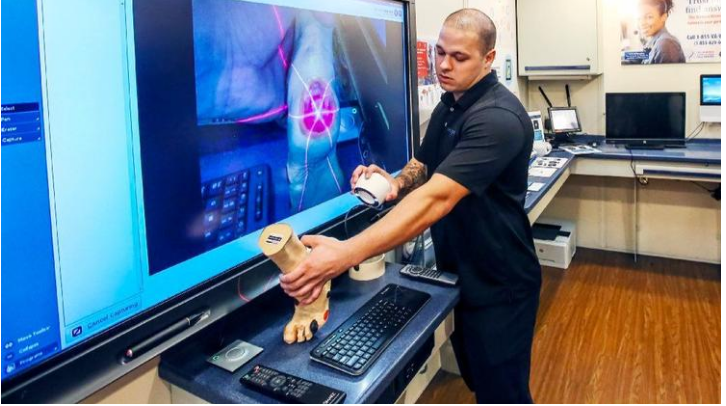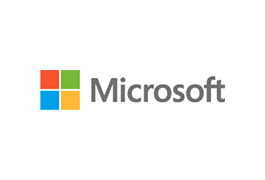25 May, 2017
By Kate Satich – Contact Reporter – Orlando Sentinel.
When Delmer Fischer needed a pair of major surgeries, the 61-year-old Army vet from Clermont had to make two eight-hour round-trips to Miami’s Veterans Affairs (VA) hospital with his wife and adult daughter, who took time off work for the operations.

Ben Engel, a veteran who now works as a trainer for Iron Bow Technologies, demonstrates a 3D laser that can be used to monitor the dimensions of a wound.
But it could have been worse. Thanks to a growing telehealth program, the Orlando VA Medical Center was able to conduct Fischer’s pre- and post-surgery visits at its Lake Nona facility, transmitting real-time information and video to the Miami surgeon.
“They took my blood pressure and vital signs and reported those to the doctor, and then he directed the nurse practitioner to pull my shirt up so he could see how the site was healing,” Fischer says of one of the post-op visits. “It was really quite amazing. The video is very high definition.”
Actually, video is one of the more pedestrian aspects of the blossoming technology, which now allows doctors to track brain waves, listen to heart beats and conduct retinal exams that detect early signs of blindness in patients hundreds of miles away. For the 110,000 veterans in the Orlando VA’s six-county service area, the technology can make the difference between getting care and going without.
“There aren’t many limitations to it,” says Brian Brennan, facility telehealth coordinator for the Orlando VA. “We can’t yet do surgery remotely, but this year we’ll see over 10,000 patients through telehealth. … A lot of them have ailments where it’s not really feasible for them to travel. They’re not ambulatory. They may have open wounds.”
Some patients are issued digital tablets with attachments they use in their homes to talk with doctors and technicians about chronic illnesses. The technology allows the doctors to see their patients’ physical conditions as well as monitor their blood pressure, temperature, heart rates and oxygen levels.
Other patients — like Fischer, who needed extensive surgery to remove cancerous tumors — go to the nearest VA facility, whether it’s a major medical center or rural clinic, so technicians there can relay information to far-away specialists. Data from retina exams, for instance, are uploaded and sent to specialists in Durham, N.C., for evaluation.
Telehealth Education Delivered – ted2go.com
During a recent stop in Orlando of a leading telehealth equipment provider, Iron Bow Technologies, trainer Ben Engel showed a VA pathologist how a single apparatus a little bigger than a water cooler can help a range of specialists relay critical information via wi-fi.
“This has about 44 modalities, from cardiology to dermatology to spirometry,” measuring how well a patient’s lungs work, Engel says, gesturing toward the equipment. “There’s a dermatology attachment for skin exams, there’s a tongue depressor attachment for inter-oral images, and then there’s an otoscope attachment for ears, nose and throat. So you have a physician directing a technician on exactly what to do, what to take a picture of, as if the technician is the physician’s hands.
“So now you’ve got a vet in a rural area who doesn’t have to travel 120 miles to have a dermatologist look at a mole.”
Telehealth itself is not new or even recent — the earliest applications began four decades ago. But its use is accelerating rapidly, especially in lower-tech encounters, such as mental-health counseling, where connecting virtually makes appointments easier for doctors and patients.
Russell Reynolds, 68, a Kissimmee veteran who served as a Marine in Vietnam, said the technology saves him time and frustration and saves the VA money. Though an outpatient clinic is only a few miles from his home, heavy traffic can turn the trip into a half-hour commute, and even then he wouldn’t be in the same room with his psychologist, he notes.
“Before I downloaded this new technology, I would go to the [outpatient] VA clinic and sit in a room to talk by video camera to someone in Orlando,” he says. “It seemed a little ridiculous. But for about four months now, all I have to do is roll out of bed and in a few minutes I’m ready for my appointment.”
Each time Reynolds is scheduled for a session, he is emailed a link that he opens on his own laptop, giving him a secure connection to the psychologist. Because he is entitled to charge the VA for care-related travel expenses, the new arrangement eliminates that expense.
On a national scale, the Department of Veterans Affairs spent about $1.05 billion on telehealth services in 2015 and $1.11 billion in 2016. It has requested $1.2 billion for next year — money the agency says will help keep veterans from more expensive emergency-room visits and hospital re-admissions.
Studies on telemedicine in nonmilitary settings tend to back that up, and the technology unquestionably reduces travel expenses. Brennan, at the Orlando VA, says his agency is tracking re-admissions and travel savings and whether telemedicine cuts down on patient no-shows for mental-health appointments. But there are no conclusions yet.
Fischer says he doesn’t need data to persuade him.
“It saved me from having to make a lot more trips to Miami — and I feel the best I have in five years,” he says. “I know the VA has gotten a bad rap, but they’ve been great for me.”





